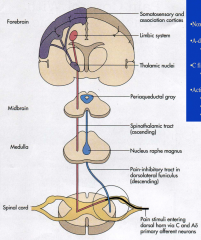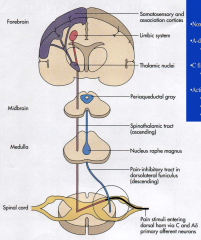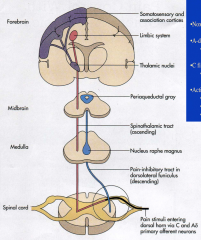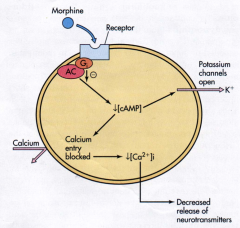![]()
![]()
![]()
Use LEFT and RIGHT arrow keys to navigate between flashcards;
Use UP and DOWN arrow keys to flip the card;
H to show hint;
A reads text to speech;
44 Cards in this Set
- Front
- Back
|
What is analgesia?
|
A state in which no pain is felt despite the presence of normally painful stimuli
|
|
|
What are analgesics?
|
Drugs that alleviate pain without impairing other sensory modalities
|
|
|
What are the receptors for pain called? What fibers does the message travel on? How does the message get to the brain?
|

- Nociceptors
- Aδ and C fibers terminate in dorsal horn of spinal cord (via glutamate and substance P) - Spinal Thalamic pathway projects from dorsal horn to thalamus, then to limbic nuclei and somatosensory and association cortex |
|
|
What is the descending pathway that modulates pain sensation?
|

- Originates in periaqueductal gray of midbrain and nuclei of rostro-ventral medulla
- Projects to dorsal horn via dorsolateral funiculus - Releases NE, serotonin, and enkephalin - Inhibits activity of ascending pain pathway (analgesic) |
|
|
Which ascending pain fibers mediate sharp localized pain to the dorsal horn of the spinal cord? Where specifically do they terminate? Which NT?
|
- Aδ fibers
- Terminate in lamina I - Uses glutamate as NT (somatic pain) |
|
|
Which ascending pain fibers mediate dull, diffuse, aching or burning pain? Where specifically do they terminate? Which NT?
|
- C fibers
- Terminate in lamina II - Uses glutamate and substance P (visceral or neuropathic pain) |
|
|
Secondary neurons bringing pain input travel on the spinothalamic tracts to what destinations?
|

- Thalamic nuclei -->
- Limbic system - Sensory and association cortex |
|
|
What are the endogenous opioid peptides? Precursors?
|
- β-endorphins - from POMC (proopiomelanocortin)
- Enkephalin - from proenkephalin - Dynorphins - from prodynorphin |
|
|
What are the three major classes of opioid receptors?
|
- Mu (µ) receptor
- Kappa (κ) receptor - Delta (δ) receptor |
|
|
What kind of proteins are the opioid receptors? Actions?
|

- G-protein coupled receptors (65% homology) - Gi
- Inhibit adenylyl cyclase - Decreases cAMP - Increases efflux of K+, hyperpolarization - Decreases influx of Ca2+ - Lowers intracellular conc. of free Ca2+ - Decreased release of NT |
|
|
What are the endogenous ligands for the mu (µ) receptor?
|
- Enkephalins
- β-endorphins |
|
|
What are the drug ligands for the mu (µ) receptor?
|
- Morphine
- Fentanyl - Methadone - Meperidine - Heroin - Codeine - Oxycodone - Buprenorphine - Hydromorphone |
|
|
What are the drug antagonists for the mu (µ) receptor?
|
- Naloxone
- Naltrexone |
|
|
What are the endogenous ligands for the kappa (κ) receptor?
|
Dynorphins
|
|
|
What are the drug ligands for the kappa (κ) receptor?
|
Nalbuphine
|
|
|
What are the endogenous ligands for the delta (δ) receptor?
|
Enkephalins, β-endorphin
|
|
|
Where are the opioid receptors localized?
|
- Found in periaqueductal gray, dorsal horns of spinal cord, medulla, and hypothalamus
- Also in peripheral organs such as GI system - Mu (µ) and delta (δ) receptors are also in limbic areas (involved in drug dependence) - Kappa (κ) receptors are also in limbic areas (involved in dysphoric actions) |
|
|
What is a narcotic?
|
Morphine like drug and some other abused substances; produce stuperous sleep-like state and may or may not be analgesic
|
|
|
What are opiates?
|
Drugs that are derived from opium or have a morphine-like pharmacological profile
|
|
|
What are opioids?
|
All opiates, agonist-antagonists, and endogenous peptides
|
|
|
How are opioid drugs administered?
|
- Oral absorption and bioavailability varies by compound (typically well absorbed)
- Also can be administered parenterally |
|
|
Which drugs have extensive first-pass metabolism / can't be administered orally?
|
- Morphine
- Naloxone |
|
|
What determines the onset of action of opioids?
|
Lipophilicity
|
|
|
What determines the duration of action of opioid drugs?
|
- Lipophilicity
- Elimination rate |
|
|
Which drugs are metabolized to active drugs by metabolism?
|
- Heroin
- Codeine |
|
|
How are opioids metabolized?
|
By liver to more polar and less active metabolites via N-dealkylation, hydrolysis, and conjugation
|
|
|
What are the effects of opioids?
|
- Analgesia
- Cough suppression - Antidiarrheal effect - Euphoria - Sedation - Respiratory depression - Nausea - Decreased LH, Increased ADH - Pupillary constriction - miosis |
|
|
How do opioids affect pain?
|
- Decrease perception of pain
- Decrease appreciation of pain |
|
|
Which drugs are most / least effective for analgesia?
|
- Most full agonists are equally effective
- Except: codeine (less effective) |
|
|
Which drugs mediate cough suppression?
|
Codeine and Dextromethorphan (may not be mediated by opioid receptors)
|
|
|
How do opioids affect bowel movements?
|
- Antidiarrheal and constipation
- Delays gastric emptying, spasmodic increases in intestinal tone and decrease propulsive movements - CNS and PNS effects - Mu (µ) receptors on GI nerves |
|
|
What is the most serious side effect of opioids?
|
Respiratory depression - due to decreased sensitivity of brainstem chemoreceptors to CO2 (additive w/ other CNS depressing drugs)
|
|
|
How do opioids affect nausea?
|
Stimulation of chemoreceptor trigger zone (CTZ) in postrema area (more when standing)
|
|
|
What are the endocrine effects of opioids?
|
- Decrease LH release - µ effect
- Increase ADH secretion - stimulated by µ receptors and decreased by κ receptors |
|
|
How do opioids affect the pupils?
|
- Constriction (miosis)
- Stimulation of Edinger-Westphal nucleus of oculomotor nerve - No tolerance for this effect (abusers will have very small pupils) |
|
|
What are the opioid antagonists?
|
- Naloxone
- Naltrexone |
|
|
What symptoms are affected by tolerance?
|
- Develops to most of the effects, rate differs:
- Rapid - emetic action - Moderate - analgesic, respiratory, euphoria, and endocrine effects - Little or no tolerance - constipation and miosis |
|
|
How are opioids affected by physical dependence?
|
- Continuous exposure to opioid analgesics results in the development of physical dependence
- When drug administration is stopped or an antagonist, such as naloxone is given, body functions abnormally |
|
|
What are the signs and symptoms of opioid withdrawal at 6-12 hours?
|
- Drug-seeking behavior
- Restlessness - Lacrimation - Rhinorrhea - Sweating - Yawning |
|
|
What are the signs and symptoms of opioid withdrawal at 12-24 hours?
|
- Restless sleep for several hours
- Irritability - Tremor - Dilated pupils - Anorexia - Goosebumps |
|
|
What are the signs and symptoms of opioid withdrawal at 24-72 hours?
|
- Increased intensity of early symptoms
- Weakness - Depression - Nausea - Vomiting - Intestinal cramps - Diarrhea - Alternating chills and flushes - Aches and pains - Increase HR and BP - Involuntary movements of arms and legs - Dehydration and possible electrolyte imbalance |
|
|
What are the signs and symptoms of opioid withdrawal after 72 hours?
|
- Earlier symptoms of autonomic hyperactivity alternate with brief periods of restless sleep w/ gradual decrease in intensity until addict recovers in 7-10 days
- Strong cravings for drug - Mild signs and symptoms are detectable for up to 6 months - Delayed growth and development in infants born to addicted mothers for up to 1 year |
|
|
What are the symptoms of opioid abuse?
|
- Euphoria
- Craving - Drug-seeking behavior - Withdrawal |
|
|
How do you treat opioid abuse?
|
- Methadone
- Buprenorphine / Naloxone - sublingual - Naltrexone - Behavioral therapy |

